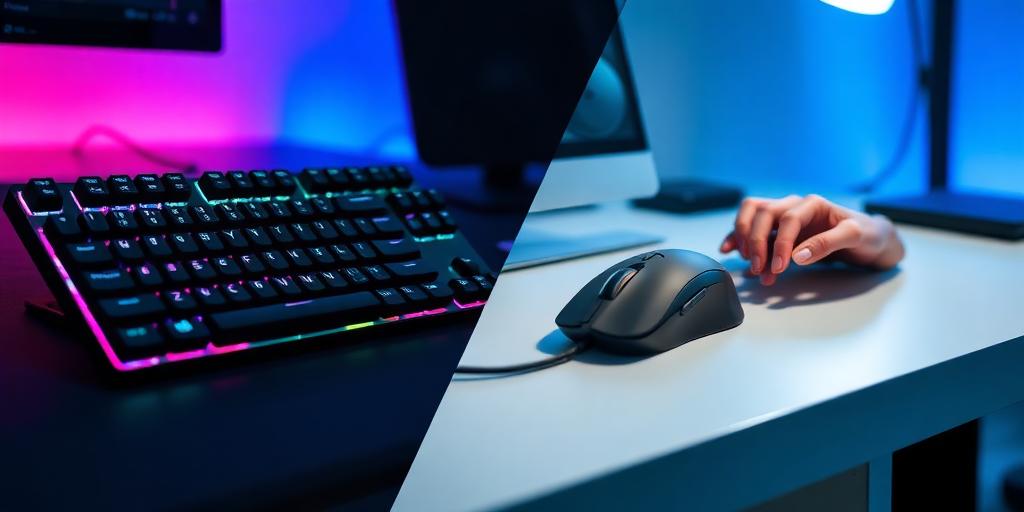Your keyboard and mouse are more than mere input devices; they are the primary interface between you and your digital world. A well-chosen peripheral setup can significantly enhance productivity, reduce fatigue, and even elevate your gaming performance. Conversely, suboptimal choices can lead to discomfort, inefficiency, and potential long-term strain. This comprehensive guide will equip you with the essential knowledge to make informed decisions when choosing keyboard and mouse components tailored to your specific needs. Before delving into the technical specifications, it is paramount to understand your primary usage patterns. Are you a professional requiring precision for data entry, a graphic designer needing ergonomic support for extended hours, a competitive gamer demanding lightning-fast response times, or a casual user seeking comfort and simplicity? Identifying your primary use case is the foundational step in selecting the optimal peripherals. Consider factors such as daily usage duration, task complexity, and whether ergonomics or high performance take precedence. An ergonomic keyboard mouse setup guide often begins here, emphasizing user-centric design.
Decoding the Keyboard Landscape
The keyboard market offers a vast array of options, each with distinct characteristics. Understanding these differences is crucial for an informed selection.
Key Switch Technologies
- Mechanical Keyboards: Renowned for their tactile feedback, durability, and precise actuation. They utilize individual switches under each key, providing a superior typing experience. A deep dive into **mechanical keyboard switch types explained** reveals variations like Cherry MX (Red, Blue, Brown) or proprietary switches, each offering different actuation forces, tactile bumps, or audible clicks.
- Membrane Keyboards: More common and affordable, these rely on a rubber dome beneath the keys that presses against a circuit layer. They are quieter but often lack the tactile precision and durability of mechanical alternatives.
- Scissor-Switch Keyboards: Frequently found in laptops, these offer a low-profile design and a shallower key travel, blending aspects of mechanical and membrane keys.
- Optical Keyboards: A newer technology, these use light beams for actuation, offering even faster response times and enhanced durability due to fewer moving parts.
Layouts and Form Factors
- Full-Size: Includes a numeric keypad, function row, and navigation keys, ideal for professionals handling extensive data entry.
- Tenkeyless (TKL): Omits the numeric keypad, offering a more compact footprint while retaining core functionality, favored by many gamers and users with limited desk space.
- Compact (60% / 65%): Significantly smaller, often requiring function key combinations for missing keys, prioritizing portability and minimalism.
Connectivity and Features
- Wired Keyboards: Offer reliable, lag-free performance, essential for competitive gaming.
- Wireless Keyboards: Provide greater flexibility and a clutter-free workspace, often utilizing Bluetooth or 2.4GHz dongles. Evaluating **wired vs wireless peripheral pros cons** is key here, considering latency versus convenience.
- Additional Features: Backlighting (RGB or monochrome), programmable macro keys, dedicated media controls, and integrated wrist rests can enhance usability and comfort.
Mastering the Mouse
Equally vital is the selection of your mouse, dictating precision, speed, and comfort.
Sensor Technologies
- Optical Mice: Utilize an LED light to track movement. They are versatile and perform well on most surfaces.
- Laser Mice: Employ a laser for tracking, offering higher DPI (dots per inch) sensitivity and greater precision, often preferred by professionals on various surfaces, including glass.
- Trackball Mice: Stationary devices where the user moves a ball to control the cursor, reducing wrist movement and beneficial for **ergonomic keyboard mouse setup guide** scenarios.
DPI and Sensitivity
DPI (or CPI - counts per inch) indicates how many pixels the cursor moves on screen for every inch the mouse moves. Higher DPI allows for faster cursor movement with minimal physical input, which is crucial in gaming peripheral selection tips for fast-paced titles. However, the optimal DPI is highly subjective and depends on screen resolution and personal preference.
Ergonomics and Grip Styles
Mouse ergonomics are critical for long-term comfort. Mice come in various shapes and sizes to accommodate different hand sizes and grip styles (palm grip, claw grip, fingertip grip). An ill-fitting mouse can lead to discomfort or repetitive strain injuries. Vertical mice are an excellent productivity keyboard mouse recommendation for those seeking to minimize wrist pronation.
Buttons and Customization
Beyond the standard left/right click and scroll wheel, many mice offer programmable side buttons, often managed through proprietary software. These can be invaluable for macros in games or shortcuts in productivity applications.
Connectivity
Similar to keyboards, mice are available in wired and wireless variants. For competitive gaming, the minimal latency of a wired mouse is often preferred. For general use and portability, a wireless mouse offers greater freedom.
Harmonizing Your Setup
The true power of your peripheral choices emerges when keyboard and mouse are selected in harmony. For a professional setup focused on data entry, a full-size mechanical keyboard with quiet, tactile switches paired with an ergonomic vertical mouse might be ideal. For a gamer, a TKL mechanical keyboard with fast, linear switches combined with a lightweight, high-DPI gaming mouse would be more appropriate. Prioritize synergy between comfort, performance, and the specific demands of your primary activities. Investing time in choosing keyboard and mouse peripherals that complement each other will yield significant dividends in both efficiency and enjoyment.
Conclusion
Selecting the right keyboard and mouse is a strategic investment in your digital comfort and efficiency. By meticulously assessing your individual needs, understanding the technical nuances of various peripheral types, and considering how these components integrate into your daily workflow, you can curate a setup that not only meets but exceeds your expectations. Take the time to research, test, and adapt, ensuring your chosen tools empower your interaction with the digital world.









